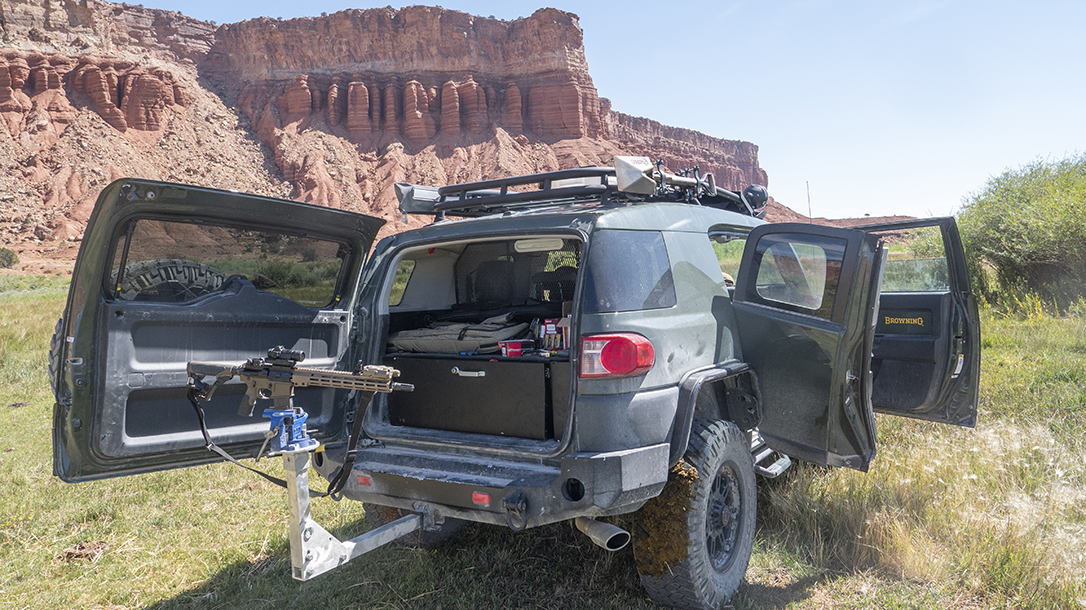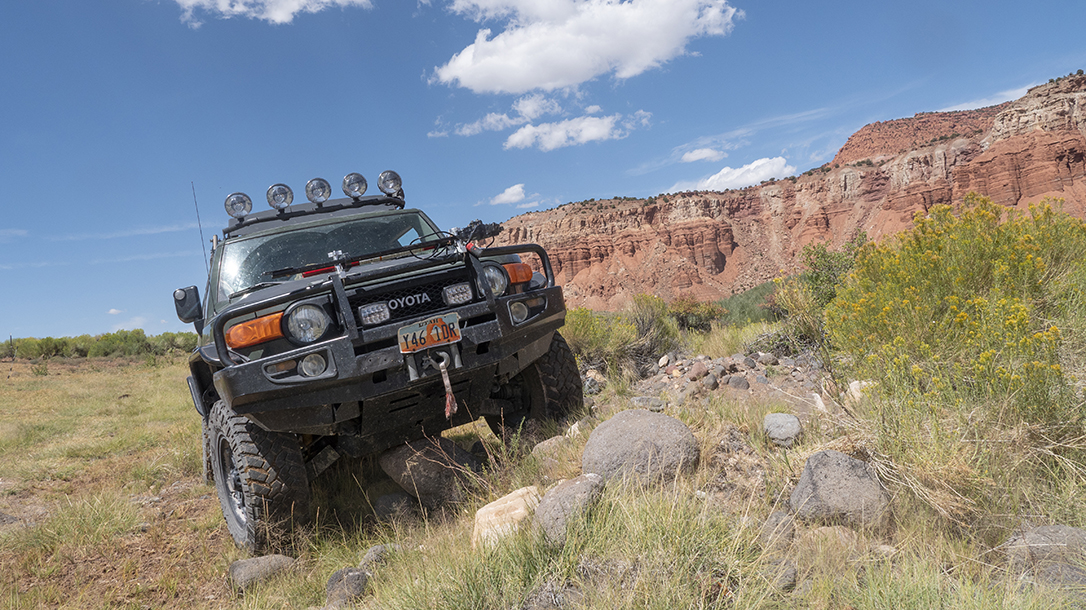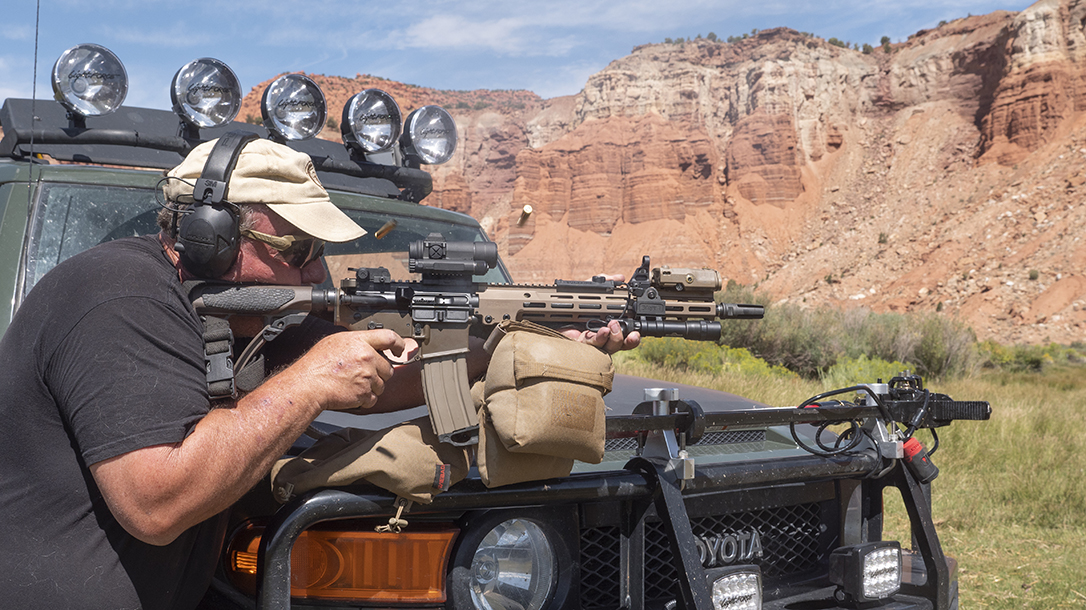Say the words “gun truck” and most people will picture a truck set up for some sort of survival or Armageddon scenario. Most of these bug-out vehicles have support for the use of firearms. But it’s not a priority, nor should it be. Firearms will come into some end-of-days or disaster scenarios, but shelter, water, medical supplies, food and even electronics are more critical. Survival in such an event is something I’ve made some preparations for, but it’s not critical in my life. My priorities were exactly the reverse.
As a shooter, trainer, photographer and gun writer, guns come first. It’s all about supporting the use and photography of firearms, both on the range and in the backcountry. Training for long-range shooting is a big part of my routine, and I often conduct that training outside normal ranges. Travel is important, since it’s not uncommon for me to cover hundreds of miles for training, hunts and other events. This vehicle needed to go wherever I needed—comfortably, reliably and in almost any weather condition, day or night. And I’m not rich, so I had a budget and had to upgrade my ride over time.
Advertisement — Continue Reading Below
Thankfully, basketball hero Karl Malone owns a Toyota dealership nestled between my home and office that provided the perfect choice. Not only is he an outdoorsman, but he also maintains a strong relationship with Browning, an iconic firearms manufacturer based in Utah.
Toyota FJ Cruiser Browning Special
My vehicle at the time of my switch was a Land Rover, a very special-edition version that was fantastic—when it ran. Anyone with firsthand experience knows the Discovery II is great but requires a lot of maintenance. Given my years as a mechanic, all of the work was performed in my shop, by me, and it only got more and more frustrating. I wanted the same capability without the workload. In 2011, the solution appeared as I wandered into Karl Malone Toyota one morning on the way to the office.
Sitting in the showroom was a 2011 Toyota FJ Cruiser Special Edition. Toyota made a limited number each year in a solid color, and in 2011, it was army green. It was also a Browning Special, something only this dealership offered, involving special stickers, seats, badges and a nylon roof bag. Bigger tires and wheels were included along with a light bar, five lights, running boards and an off-road package including an electronic locking rear differential traction control system and a starter drive function. A standard transmission meant lower gears—perfect for the bigger tires.
Advertisement — Continue Reading Below
As is often the case with dealerships, the “suspension upgrade” was nothing more than spacers. It looks cool but is useless off-road. With a heavy-duty front and rear bumper in the cards, I added a set of Old Man Emu (OME) shocks and coil springs. Designed for use in the Australian Outback, they are extremely durable, low maintenance and easy to install. Other upgrades include an ARB USA Deluxe Bull Bar bumper and fog lights, a Warn Industries winch and a trailer hitch vise for working on guns or adding accessories, creating sort of a gun shop on wheels. I added these features over a weekend and took it on its first cross-country trip the following week—one of many it would achieve over the next several years.
More Upgrades
Following a trip to the southern tip of Texas for a media event and a couple other trips to Texas, Washington and Arizona, one thing became clear: The Toyota FJ Cruiser needed a bigger gas tank. Using 4-gallon cans from Rotopax mounted on the roof rack helped, but Toyota had installed a small tank—more grocery-getter than trekker. It was time to step it up, and more Australian gear was in order: a 30-gallon, aluminized sheet-steel replacement gas tank from Long Range Automotive. I turned to Cruiser Outfitters in Sandy, Utah, for the installation, and replaced the Rotopax gas cans with water containers.
I live and work in the desert terrain of Utah. So I added an ARB awning to the driver’s side for some shade. My larger tires kept hitting the factory fender flares. I installed a set of Warrior Products tubular flares and took the Toyota FJ Cruiser back to Cruiser Outfitters for a “body mount chop.” This provides more travel for the tires by removing some metal from the front body mounts and welding on some plates for added strength. Oversized tires and Black Rhino hard wheels are heavy. So an Expedition One rear bumper with a swing-out tire arm made things more solid.
Advertisement — Continue Reading Below
I also added a custom cabinet system for the back that lasted for years. Aluminum skid plates from Ricochet Off-Road protected the important bits from rocks and debris. The owner of Ricochet, which specializes in UTVs and ATVs, happens to have an FJ Cruiser. So the company makes a set for it that provides complete protection for the engine, transmission and even the transfer case without adding a ton of weight. And that was pretty much it for several years—until recently.
Lights, Cabinet, Action
The original lights above the windshield looked cool but weren’t actually that effective. So I contacted my friend and colleague Thomas Carlson at Lightforce (lightforce.com) to obtain some LED replacements. I also ordered five 170mm Striker halogen lights. Why halogen? Simple: They work with infrared filters, meaning I can have fun driving at night while using night-vision goggles. The 100-watt front lights can also switch from spot to flood without being replaced. The installation was easy using the standard wiring.
My old cabinet was hammered after years of daily use, so Tuffy Products sent me one of its Security Cargo Drawer systems. The installation was pretty straightforward, and the new system provides deeper space in the drawer and more clearance on top. The drawer is very smooth, and a set of dividers lets me set things up for my camera and other essentials. A Springtail Solutions Pet and Cargo Barrier lets me stack things as needed without them all working forward.
Advertisement — Continue Reading Below
Finally, I needed to adjust my old Hi-Lift jack. This time I used some tube clamps and mounted it to the front bumper, the easiest location to access in the field. Securing it with a Bolt cable lock keeps it secure. I tend to lose small keys, but the Bolt lock allows me to use my ignition key.
Still Running Strong
This isn’t your typical project truck or advertising tool like the ones you see parked at gun shows and events. For years, the Toyota FJ Cruiser was my everyday driver, and I used it to traverse the country. It’s been used as a work vehicle since day one and continues to serve as such. Several times a week, it’s driven out to Follow Through Consulting or other ranges within a few hours. My 2015 Dodge Ram has taken over the long-haul duties, but other than that, I use the FJ Cruiser exclusively.
Advertisement — Continue Reading Below
At just over 130,000 miles, it’s never thrown a code or check-engine light. I haven’t had to perform any mechanical maintenance other than change the tires, oil, filters, fluids and windshield. It’s never failed to start in conditions ranging from -20 to over 120 degrees Fahrenheit. Mud, snowdrifts, blowing snow, sleet, hail, even a tornado or two—you name it and the FJ Cruiser has gone through it. Sure, it has a number of scratches from trees and rocks. The interior is a bit beat up thanks to lots of work and several dogs. Holsters have worn a hole in the seat, too, but nothing has broken, and I’m not sure I could ask for more.
Seven years ago, I wanted a reliable go-anywhere vehicle designed to make my job easier and me look pretty cool while doing it. This Toyota FJ Cruiser has done so perfectly. Sadly, Toyota doesn’t make them anymore, so it will have to keep doing it for years to come. My guess is it’ll do just fine and may just outlive its owner!
This article is from the March 2019 issue of Tactical Life magazine. Grab your copy at OutdoorGroupStore.com. For digital editions, visit Amazon.
Advertisement — Continue Reading Below

























